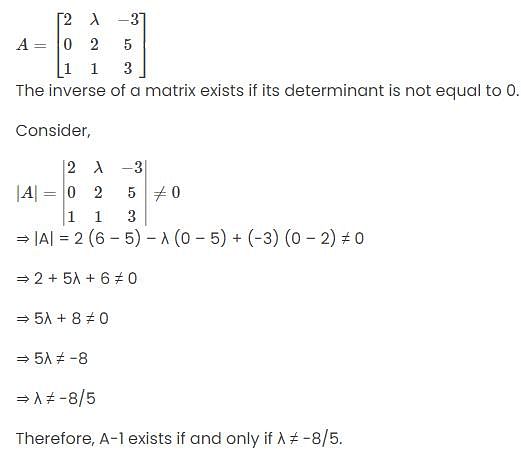JEE Exam > JEE Tests > Mathematics (Maths) for JEE Main & Advanced > Test: Determinants - 1 - JEE MCQ
Test: Determinants - 1 - JEE MCQ
Test Description
25 Questions MCQ Test Mathematics (Maths) for JEE Main & Advanced - Test: Determinants - 1
Test: Determinants - 1 for JEE 2024 is part of Mathematics (Maths) for JEE Main & Advanced preparation. The Test: Determinants - 1 questions and answers have been
prepared according to the JEE exam syllabus.The Test: Determinants - 1 MCQs are made for JEE 2024 Exam. Find important
definitions, questions, notes, meanings, examples, exercises, MCQs and online tests for Test: Determinants - 1 below.
Solutions of Test: Determinants - 1 questions in English are available as part of our Mathematics (Maths) for JEE Main & Advanced for JEE & Test: Determinants - 1 solutions in
Hindi for Mathematics (Maths) for JEE Main & Advanced course. Download more important topics, notes, lectures and mock
test series for JEE Exam by signing up for free. Attempt Test: Determinants - 1 | 25 questions in 25 minutes | Mock test for JEE preparation | Free important questions MCQ to study Mathematics (Maths) for JEE Main & Advanced for JEE Exam | Download free PDF with solutions
Detailed Solution for Test: Determinants - 1 - Question 1
Detailed Solution for Test: Determinants - 1 - Question 2
| 1 Crore+ students have signed up on EduRev. Have you? Download the App |
Detailed Solution for Test: Determinants - 1 - Question 3
Test: Determinants - 1 - Question 4
If A and B matrices are of same order and A + B = B + A, this law is known as
Detailed Solution for Test: Determinants - 1 - Question 4
Detailed Solution for Test: Determinants - 1 - Question 5
Detailed Solution for Test: Determinants - 1 - Question 6
Detailed Solution for Test: Determinants - 1 - Question 7
Detailed Solution for Test: Determinants - 1 - Question 8
Detailed Solution for Test: Determinants - 1 - Question 9
Detailed Solution for Test: Determinants - 1 - Question 10
Detailed Solution for Test: Determinants - 1 - Question 11
Detailed Solution for Test: Determinants - 1 - Question 12
Test: Determinants - 1 - Question 13
If A is a non singular matrix of order 3 , then |adj(A3)| =
Detailed Solution for Test: Determinants - 1 - Question 13
Test: Determinants - 1 - Question 14
If A and B are any 2 × 2 matrices , then det. (A+B) = 0 implies
Detailed Solution for Test: Determinants - 1 - Question 14
Detailed Solution for Test: Determinants - 1 - Question 15
Detailed Solution for Test: Determinants - 1 - Question 16
Detailed Solution for Test: Determinants - 1 - Question 17
Detailed Solution for Test: Determinants - 1 - Question 18
Detailed Solution for Test: Determinants - 1 - Question 19
Test: Determinants - 1 - Question 20
If A and B are square matrices of same order and A’ denotes the transpose of A , then
Detailed Solution for Test: Determinants - 1 - Question 20
Detailed Solution for Test: Determinants - 1 - Question 21
Detailed Solution for Test: Determinants - 1 - Question 22
Test: Determinants - 1 - Question 23
If the entries in a 3 x 3 determinant are either 0 or 1 , then the greatest value of this determinant is :
Detailed Solution for Test: Determinants - 1 - Question 23
Detailed Solution for Test: Determinants - 1 - Question 24
Test: Determinants - 1 - Question 25
In a third order determinant, each element of the first column consists of sum of two terms, each element of the second column consists of sum of three terms and each element of the third column consists of sum of four terms. Then it can be decomposed into n determinants, where n has value
Detailed Solution for Test: Determinants - 1 - Question 25
|
209 videos|443 docs|143 tests
|
Information about Test: Determinants - 1 Page
In this test you can find the Exam questions for Test: Determinants - 1 solved & explained in the simplest way possible.
Besides giving Questions and answers for Test: Determinants - 1, EduRev gives you an ample number of Online tests for practice
|
209 videos|443 docs|143 tests
|
Download as PDF


 , then Det. A is
, then Det. A is 






 is
is , Apply , C2 → C2 + C3
, Apply , C2 → C2 + C3

 are
are
 is equal to
is equal to 









 , then equals
, then equals





 are
are
















